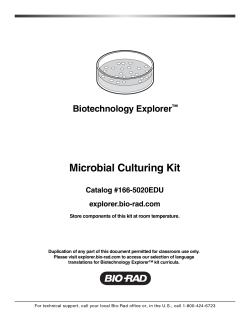
Sample questions from old exam I BCHS 3304 – Dr. Yeo T
Sample questions from old exam I BCHS 3304 – Dr. Yeo I. True or False (#1 to 5)? 1. 2 T T F F In the tripeptide Arg-Pro-Tyr, the C-terminal residue is Arg. Open systems, such as living creatures, are not at equilibrium. 3 T F Hydrophilic substances such as ions and polar molecules dissolve readily in water. 4 T F 5 T F Buffered solutions resist changes in pH within about one pH unit of the pK of the buffering species. Amino acids may be covalently modified after they have been incorporated into a polypeptide. II. Calculations [A: #6 -8]. The molecular weight of the antibiotic ampicillin is 349 g/mole. Calculate how much ampicillin you would need to make 10 ml of a 1000x solution (1000-fold concentrated) for each of the following: 6. 50 μg/ml ampicillin. A. 100 mg ampicillin C. 500 mg ampicillin E. 5 g ampicillin B. 10 g ampicillin D. 50 g ampicillin 7. 1 mM ampicillin. A. 34.9 mg ampicillin C. 34.9 g ampicillin E. 1.75 g ampicillin B. 3.49 g ampicillin D. 17.5 g ampicillin 8. Calculate how much of the solid reagents (chemical) you would add to make 500 ml of 10x TBE buffer solution. 10x TBE (0.9 M Tris, 0.9 M Boric acid, 20 mM EDTA) Tris (MW = 121 g/mole) Boric acid (MW = 61.8 g/mole) EDTA (MW = 292 g/mole) A. B. C. D. E. 108 g Tris, 55.6 g Boric acid, 5.84 g EDTA 54.4 g Tris, 27.8 g Boric acid, 2.92 g EDTA 108 g Tris, 27.8 g Boric acid, 2.92 g EDTA 54.4 g Tris, 55.6 g Boric acid, 5.84 g EDTA 121 g Tris, 61.8 g Boric acid, 292 g EDTA 1 III. Other multiple-choice questions 9. The theory of evolution includes the following principles: A. B. C. D. E. evolution is not directed toward a specific goal. evolution is ongoing, and is constrained by its past. evolution requires some “sloppiness” for adaptation to changes. A and B A, B, and C 10. Calculate G° for the reaction A + B C + D at 25°C when the equilibrium conditions are [A] = 10 mM, [B] = 15 mM, [C] = 10 mM, [D] = 10 mM (Gas constant: 8.31 J•K-1•mol-1). A. 1004 J/mol B. 10 kJ/mol C. 5 kJ/mol D. 1 J/mol E. insufficient data to determine answer 11. A reaction with H = 23 kJ/mol and S =22 J/K·mol, at 2°C, is: A. B. C. D. E. spontaneous nonspontaneous at equilibrium impossible to determine reactivity none of the above 12. If gas molecules in an enclosed space are allowed to enter a second chamber, the resulting distribution of gas molecules represents and increase in A. B. C. D. E. enthalpy entropy force A and C A, B, and C 13. Amphiphilic molecules: A. B. C. D. E. have both oxidizing and reducing groups. are micelles. have chromophores in two different wavelength regions. have both acidic and basic groups. have both hydrophilic and hydrophobic groups. 2 14. Which of the following amino acids has a sulfur atom in its side chain? A. B. C. D. E. Asn Ser Phe Cys Thr 15. At pH 7, arginine (pKs are -carboxylate 1.82, -amino 8.99, guanidino 12.48) would be charged as follows: A. B. C. D. E. 0 -carboxylate, 0 -amino, +1 guanidino, +1 net charge +1 -carboxylate, 0 -amino, –1 guanidino, 0 net charge +1 -carboxylate, –1 -amino, –1 guanidino, –1 net charge –1 -carboxylate, +1 -amino, +1 guanidino, +1 net charge –1 -carboxylate, 0 -amino, +1 guanidino, 0 net charge 16. Which of the following amino acids would you expect to find in the interior of a protein’s tertiary structure? A. B. C. D. E. Phe Thr Asn Lys All of the above 17. What is the pH of 0.001 M solution of NaOH? A. B. C. D. E. 2 10 11 12 13 18. In two homologous proteins, which residue is most likely to replace a Asp residue as a conservative substitution? A. B. C. D. E. Ala Gln Asn Arg Glu 3 19. You must cleave the following peptide into smaller fragments. Which of the proteases would be likely to yield the most fragments? (Refer to the table below) NLTQGRCKPENTFVHSPEVPVQPVC A. B. C. D. E. Trypsin Chymotrypsin Elastase Endopeptidase V8 Pepsin 4
© Copyright 2025










